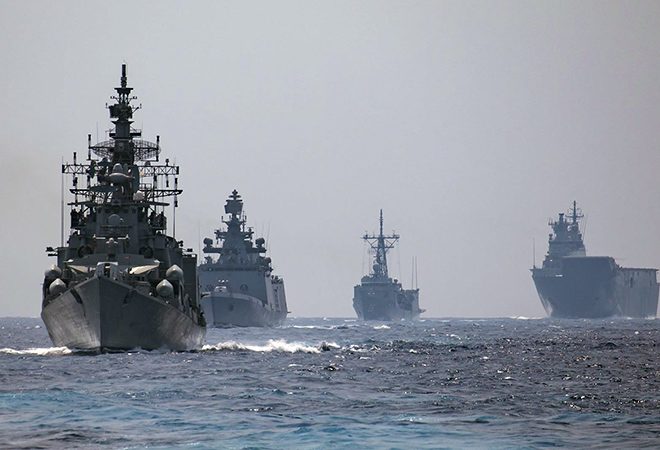Will Australia join the Malabar exercises? For weeks, Indian media has reported with near certitude that New Delhi will be inviting Canberra to join its high-level naval exercises, which usually involve the navies of India, Japan, and the United States. While strategic dialogue and informal cooperation has long existed between the four countries, known as the Quadrilateral Security Dialogue, the exercises would mark the first time Australia would be part of this official joint military engagement. For India, the decision to extend the invitation—a move it had so far held back on despite interest from Australia—marks a major step. Not only does New Delhi hope to strengthen its relations with its partners in the Indo-Pacific, but it intends to send a strong message to Beijing as border tensions mount: India’s military partnerships are growing stronger than ever, and Chinese intransigence will make them even more potent.
Not only does New Delhi hope to strengthen its relations with its partners in the Indo-Pacific, but it intends to send a strong message to Beijing as border tensions mount: India’s military partnerships are growing stronger than ever, and Chinese intransigence will make them even more potent.
India-Australia relations have evolved rapidly over the past five years, and this development is a natural corollary. When Indian Prime Minister Narendra Modi and his Australian counterpart Scott Morrison held their first virtual bilateral meeting in June, the pair offered up a number of significant agreements. The signed accords included the Mutual Logistics Sharing Agreement, allowing the two nations to use each other’s military bases for logistics support improving military partnership. The two countries also agreed to elevate their ties to a comprehensive strategic partnership, which is based on “mutual understanding, trust, common interests and the shared values of democracy and rule of law.” This is symbolic of their commitment to strengthen their engagement in the Indo-Pacific for the promotion of an “open, free, rules–based Indo-Pacific region supported by inclusive global and regional institutions,” as the two countries put it in a joint statement last month.
The timing of such accords couldn’t be better for two nations that have been at the receiving end of China’s aggressive actions. Tensions between Australia and China have been high since Canberra in April called for an investigation into the origins of COVID-19. China responded by reportedly drawing up a list of Australian exports that could be subject to tariffs and stricter controls. India, for its part, has been facing a tense standoff with China after border clashes last month resulted in the death of 20 Indian border troops and an unknown number from the Chinese side. Although the two sides are now in the process of disengaging after diplomatic and military talks, tensions over the long undemarcated border, the Line of Actual Control, mark perhaps the worst Sino-Indian crisis since the 1960s.
Amid this rising assertiveness by China, Canberra stands to gain a partnership it has long desired. For years, Australia has wanted to be party to the exercises, even agreeing to join in as an observer in 2017. But India, trying to tread cautiously vis-à-vis China, had not been enthusiastic. Now, its calculations have changed. The choice to join hands and develop a stronger stance against China with like-minded countries no longer seems radical. For Australia and India, stronger defense partnership is essential to achieving a “free and open” Indo-Pacific.
For years, Australia has wanted to be party to the exercises, even agreeing to join in as an observer in 2017. But India, trying to tread cautiously vis-à-vis China, had not been enthusiastic.
Faced with an increasingly powerful and aggressive China, countries such as Australia, Japan, the United States, and even members of the Association of Southeast Asian Nations (ASEAN) are all rethinking and remapping their China policies—particularly with regards to its incursions in the South China Sea. ASEAN recently released a vision statement where it underlined the need for China to abide by international law and to finalize the China-ASEAN Code of Conduct for the South China Sea. The United States this month strongly condemned China’s actions in the South China Sea, calling its efforts “completely unlawful.” Australia recently announced its 2020 Defence Strategic Update—a wide ranging, 10-year defense plan of 270 billion Australian dollars ($189 billion).
Defense partnerships are central to any effort to counter China. Inviting Australia to the Malabar exercises would significantly strengthen the military quotient of the Quadrilateral grouping. If Australia is given the go-ahead to join the exercise, it will be first time since 2007 that all four Quad members participate in a joint military drill. The Quad went on hiatus from 2008 to 2017, and while has been operational since 2017, it only took off in a significant way after a meeting between the countries’ foreign ministers in September 2019. Prior to the 2019 meeting, summits ended with each country issuing its own statement outlining its own priorities—rather than a joint one. Quad members had been making very calculated statements when it came to China’s actions in the South China Sea, among other issues. But with all four nations sharing an equal sense of urgency about China, priorities are now aligned. Adding a military partnership element to the Quad is a logical step, given the serious security challenges emanating from China’s growing aggression toward the four powers.
If Australia is given the go-ahead to join the exercise, it will be first time since 2007 that all four Quad members participate in a joint military drill.
Australia’s full induction into the Quad has implications for India’s broader approach to the Indo-Pacific as well. Previously, given Chinese reservations, New Delhi was reluctant to term its Indo-Pacific policy as a strategy, and mostly referred to it as its “vision” of the Indo-Pacific. The country was hesitant to even tie its own Indo-Pacific policy into that of the Quad, arguing that its own policy was more inclusive. In his keynote address at the Shangri-La Dialogue in June 2018, Modi noted that the geography of the Indo-Pacific stretches from the eastern coast of Africa to Oceania and stressed that “India does not see the Indo-Pacific region as a strategy or as a club of limited members.” But as the Quad starts to leverage its hard power, and as India’s relations with China deteriorate, New Delhi is likely to reshape its Indo-Pacific strategy alongside its partners. Inviting Australia for the Malabar exercise is a natural first step.
Given China’s growing presence in the Indian Ocean—widely considered India’s primary theater of interest—there has long been a sense in New Delhi that it ought to increase its presence and influence in the Western Pacific.
Given China’s growing presence in the Indian Ocean—widely considered India’s primary theater of interest—there has long been a sense in New Delhi that it ought to increase its presence and influence in the Western Pacific. China’s growing encroachments in the South China Sea and East China Sea—an attempt to intimidate smaller neighbors—has made it imperative for states such as India to be more hands-on in maritime disputes.
Australia, Japan, and the United States are prominent players in the Western Pacific. Australia has been lending support alongside the United States in freedom-of-navigation exercises and joint patrols in the disputed South China Sea. If India can grow its presence in the eastern Indian Ocean and gain the trust of its Southeast Asian neighbors, New Delhi’s credibility as a serious strategic player in the wider region will be enhanced, which is important for the success of the Quad. Besides the security connotations, the Quad remains critical as India seeks to build alternative supply chains, collaborate on COVID-19 treatments, and reduce its economic dependence on China—something which has been gathering pace over the past few months.
Besides the security connotations, the Quad remains critical as India seeks to build alternative supply chains, collaborate on COVID-19 treatments, and reduce its economic dependence on China—something which has been gathering pace over the past few months
None of these developments will make China happy, and they risk making the countries involved the targets of its vengeance. Beijing has been against this informal grouping since 2007, when the Quad was first conceived. But given China’s aggressive actions, it is unlikely that its opinion will be a serious consideration for regional policymakers. Their approach thus far—first, not moving past talks to operationalize the Quad, and then deliberately forestalling any use of its military dimension—hasn’t yielded any dividend to Quad members. This is particularly true of India, where the ongoing boundary tussle with China has significantly eroded the remnants of trust between the two Asian giants. By inviting Australia to the Malabar exercises, New Delhi is signaling that it might be willing not only to shed its past caution in standing up to Beijing, but to bear the costs that might come with such a decision. However, whether it will be enough to deter China from its aggressive intentions remains far from clear.
This commentary originally appeared in Foreign Policy.
The views expressed above belong to the author(s). ORF research and analyses now available on Telegram! Click here to access our curated content — blogs, longforms and interviews.




 PREV
PREV



